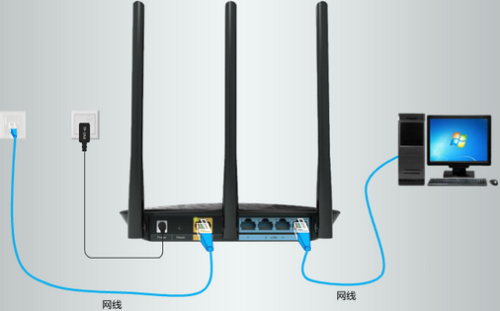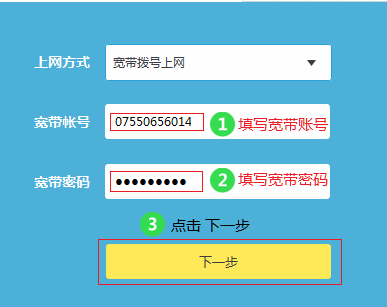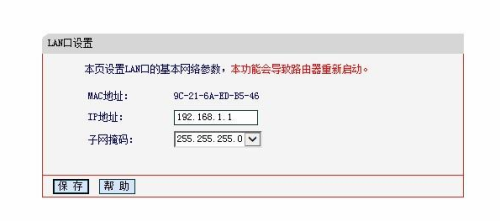 Computer Tutorials
Computer Tutorials
 Computer Knowledge
Computer Knowledge
 Why is my home wireless network suddenly unable to connect to my mobile phone?
Why is my home wireless network suddenly unable to connect to my mobile phone?
Why is my home wireless network suddenly unable to connect to my mobile phone?
Why can’t my phone suddenly connect to the wireless network at home
Internet access on mobile phones has become one of daily activities, and many people connect to the Internet wherever there is WiFi. However, sometimes even if you know the WiFi password, you cannot connect. Here are some methods to solve the problem of failure to connect to WiFi.
Methods to solve the problem of failure of mobile phone to connect to WiFi
When confirming the password, please make sure the password is correct and pay attention to the case-sensitive letters. It is recommended to enter the password by displaying it and click the "eye icon".
2. Reconnect: Select the connected WIFI in [Settings-WLAN], click "Forgot Network/Forgot Password" and try to reconnect.
3. Restart the WIFI hotspot (router): power off the router for 10 seconds and then power it on again to check whether the connection can be normal.
If your router sets MAC connection restrictions, it may result in the inability to connect to WIFI hotspots. You can check the router manual, enter the router settings interface, and view related settings. If necessary, you can restore the router to factory settings and then perform a connection test. However, please note that restoring factory settings will cause the broadband account and password saved in the router to be lost. Before operating, please make sure you remember your broadband account number and password, or consult the broadband operator's service hotline for relevant information.
5. Compare other mobile phones: Use the comparison method to observe other mobile phones connected to the same WIFI to confirm whether it is the WIFI problem or the mobile phone problem.
On the mobile phone, you can restore the system by entering [Settings-More Settings-Restore Factory Settings or Backup and Reset-Restore All Settings]. Please note that after restoration, account-based applications such as WeChat need to re-verify passwords to log in.
7. Customer Service Center Test: If it is still abnormal after the above troubleshooting, please bring your mobile phone and relevant credentials to the Customer Service Center for testing.
My router cannot connect to the Internet. How should I set it up?
Causes and solutions:
1. Router socket connection error
The first step for users should check whether the socket is connected incorrectly. The WAN interface is the network access socket of the router. It usually connects the optical modem and the network cable. If the computer is connected to the LAN interface, you can choose any LAN interface to connect to the computer.

2. Wrong way to access the Internet
Usually when we set up a router, we have three Internet access methods to choose from, namely broadband dial-up Internet access, automatically obtaining an IP address for Internet access, and fixed IP address Internet access. Usually we use broadband dial-up Internet access (pppoe) at home. Be careful not to Wrong choice.

3. Wrong broadband account and password
Incorrect broadband installation and password will cause the router to be unable to access the Internet after it is set up. If you forget it, you can call the broadband operator to ask for it.

4. The IP address of the LAN port has not been modified
When the user selects the Internet access method to automatically obtain an IP address, in order to avoid IP address conflicts, the IP address of the LAN port must be modified under the network parameters of the router.

Extended information
Connect different networks
From the perspective of filtering network traffic, routers function very similarly to switches and bridges. However, unlike switches that work at the physical layer of the network and physically divide network segments, routers use specialized software protocols to logically divide the entire network. For example, a router that supports the IP protocol can divide the network into multiple subnet segments, and only network traffic directed to special IP addresses can pass through the router.
For each received data packet, the router will recalculate its check value and write a new physical address. Therefore, using a router to forward and filter data tends to be slower than a switch that only looks at the physical address of the packet. However, for those networks with complex structures, using routers can improve the overall efficiency of the network. Another obvious advantage of the router is that it can automatically filter network broadcasts. Generally speaking, the entire installation process of adding a router to the network is much more complicated than a plug-and-play switch.
Information transfer
Some routers only support a single protocol, but most routers can support the transmission of multiple protocols, that is, multi-protocol routers. Since each protocol has its own rules, completing the algorithms of multiple protocols in one router will inevitably reduce the performance of the router. The main job of the router is to find an optimal transmission path for each data frame passing through the router, and to effectively transmit the data to the destination site.
It can be seen that the strategy of selecting the best path, that is, the routing algorithm, is the key to the router. In order to complete this work, data related to various transmission paths - a routing table (Routing Table) - is stored in the router for use in routing selection. The path table stores subnet identification information, the number of routers on the network, and the name of the next router. The path table can be fixed and set by the system administrator.
Static routing table: A fixed path table set in advance by the system administrator is called a static path table.
Dynamic routing table: The dynamic (Dynamic) path table is a path table that the router automatically adjusts according to the operating conditions of the network system.
Reference: Sogou Encyclopedia Functions of Routers
I’m also wondering why my wifi search can’t connect but what could be the cause
There are several possible reasons why the wifi signal cannot be connected:
1. The WiFi signal is relatively weak
If a smartphone, tablet or laptop can search for a Wifi wireless signal but cannot connect, the user can look at the Wifi signal strength displayed on the device. If the Wifi signal is only one or two bars, it may appear If the connection fails, the user can get as close to the router as possible to enhance the Wifi signal, and then connect again.
The WiFi transmission capability of ordinary wireless routers is poor. For example, walls, big trees, and other obstacles may affect the WiFi signal, causing the signal to be received, but unable to connect for a while.
2. There are many access devices
In many public Wi-Fi places, even though the Wi-Fi signal is very strong and reaches full capacity, there will be cases where the Wi-Fi signal is available but cannot be connected. This is probably because there are too many wireless devices connected, causing the wireless router to be unable to provide The user is assigned an IP address and cannot connect to it.
The bandwidth of WiFi Internet access and the user devices that the router can access are also limited. Therefore, it is impossible to add devices wirelessly to the Wifi wireless network. When the broadband is very sufficient, a general wireless router can access up to about 200 devices. (Theoretically, the IP addresses that the router can assign are 2-254), but considering that the general broadband is not very large, in fact, there are not many Wifi devices that a single wireless router can access, so in some cases where there are many people, And in places with public Wi-Fi, there are likely to be too many access devices, causing subsequent users to be unable to connect.
3. Wireless router setting restrictions
The wifi has a signal but cannot connect. Another possibility is that there are restrictions set inside the wireless router. For example, many families or businesses are worried about people nearby using the Internet, so they will make advanced settings on the router, such as binding the device Mac to only allow Some of the devices set up can be connected, which will cause other unfamiliar wireless devices to be unable to connect.
Solution: You can cancel the router's MAC binding device settings, or you can add a new device MAC address binding in the router settings.
In general, the most likely reasons why the wifi signal cannot be connected are the above three reasons. You may wish to analyze according to your own Internet environment. If it is a wireless router at home or that you can control, and there is a Wifi signal but cannot be connected, you can first check the signal strength, and then check the router settings to solve the problem.
The above is the detailed content of Why is my home wireless network suddenly unable to connect to my mobile phone?. For more information, please follow other related articles on the PHP Chinese website!

Hot AI Tools

Undresser.AI Undress
AI-powered app for creating realistic nude photos

AI Clothes Remover
Online AI tool for removing clothes from photos.

Undress AI Tool
Undress images for free

Clothoff.io
AI clothes remover

AI Hentai Generator
Generate AI Hentai for free.

Hot Article

Hot Tools

Notepad++7.3.1
Easy-to-use and free code editor

SublimeText3 Chinese version
Chinese version, very easy to use

Zend Studio 13.0.1
Powerful PHP integrated development environment

Dreamweaver CS6
Visual web development tools

SublimeText3 Mac version
God-level code editing software (SublimeText3)

Hot Topics
 1382
1382
 52
52
 Discover How to Fix Drive Health Warning in Windows Settings
Mar 19, 2025 am 11:10 AM
Discover How to Fix Drive Health Warning in Windows Settings
Mar 19, 2025 am 11:10 AM
What does the drive health warning in Windows Settings mean and what should you do when you receive the disk warning? Read this php.cn tutorial to get step-by-step instructions to cope with this situation.
 How do I edit the Registry? (Warning: Use with caution!)
Mar 21, 2025 pm 07:46 PM
How do I edit the Registry? (Warning: Use with caution!)
Mar 21, 2025 pm 07:46 PM
Article discusses editing Windows Registry, precautions, backup methods, and potential issues from incorrect edits. Main issue: risks of system instability and data loss from improper changes.
 How do I manage services in Windows?
Mar 21, 2025 pm 07:52 PM
How do I manage services in Windows?
Mar 21, 2025 pm 07:52 PM
Article discusses managing Windows services for system health, including starting, stopping, restarting services, and best practices for stability.
 How to Fix the Steam Cloud Error? Try These Methods
Apr 04, 2025 am 01:51 AM
How to Fix the Steam Cloud Error? Try These Methods
Apr 04, 2025 am 01:51 AM
The Steam Cloud error can be caused by many reasons. To play a game smoothly, you need to take some measures to remove this error before you launch the game. php.cn Software introduces some best ways as well as more useful information in this post.
 Windows Metadata and Internet Services Problem: How to Fix It?
Apr 02, 2025 pm 03:57 PM
Windows Metadata and Internet Services Problem: How to Fix It?
Apr 02, 2025 pm 03:57 PM
You may see the “A connection to the Windows Metadata and Internet Services (WMIS) could not be established.” error on Event Viewer. This post from php.cn introduces how to remove the Windows Metadata and Internet Services problem.
 How do I change the default app for a file type?
Mar 21, 2025 pm 07:48 PM
How do I change the default app for a file type?
Mar 21, 2025 pm 07:48 PM
Article discusses changing default apps for file types on Windows, including reverting and bulk changes. Main issue: no built-in bulk change option.
 How to Resolve the KB5035942 Update Issues – Crashing System
Apr 02, 2025 pm 04:16 PM
How to Resolve the KB5035942 Update Issues – Crashing System
Apr 02, 2025 pm 04:16 PM
KB5035942 update issues - crashing system commonly happens to users. Inflicted people hope to find a way out of the kind of trouble, such as crashing system, installation, or sound issues. Targeting these situations, this post published by php.cn wil
 How do I use the Group Policy Editor (gpedit.msc)?
Mar 21, 2025 pm 07:48 PM
How do I use the Group Policy Editor (gpedit.msc)?
Mar 21, 2025 pm 07:48 PM
The article explains how to use the Group Policy Editor (gpedit.msc) in Windows for managing system settings, highlighting common configurations and troubleshooting methods. It notes that gpedit.msc is unavailable in Windows Home editions, suggesting



